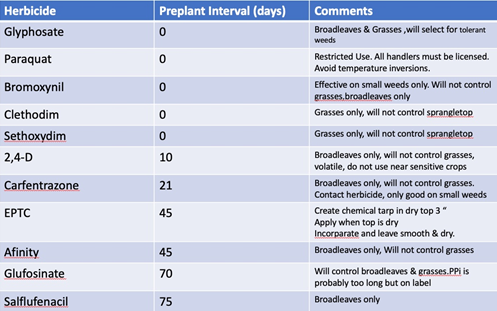It is much easier to kill weeds when there is no crop in the field and now is a good time to reduce the weed seed bank of weeds in fallow fields. It is an especially valuable time to reduce the population of perennial weeds, like nutsedge, that will continue to get worse every year until the field is almost unfarmable for many crops. Weed seeds are buried at variable depths in the soil, some have hard seed coats and there are other variables that cause them to germinate over a long period of time. If they all came up at the same time they would be much easier to control. It takes time, therefore, to repeatedly irrigate, germinate and kill weeds with either tillage or herbicides. We have conducted trials that indicate that in most years summer annual weeds begin to germinate in February, reach a peak in June but continue to germinate into October. Perennial weeds often have to be actively growing to be adequately controlled and now is a good time to get started.
Tillage Repeated germination and tillage of small annual weeds can be very effective at reducing the weed seed bank. It can also spread weeds in some situations. Proper timing of tillage to kill weeds can be important with some species. Succulent weeds like purslane can survive for several days after cultivation or hoeing. They can reroot at the nodes and continue to grow if they are allowed to get too big before they are uprooted. Growers sometimes allow early emerging weeds to get fairly big in an effort to germinate as many seeds as possible. Incorporating big weeds can temporarily build up large amounts of organic matter into the soil and have a negative effect on some preemergent herbicides used in vegetables. Many of the root and shoot inhibitor herbicides like Trifluaralin, Pendimethalin, Benefin, DCPA and others can bind to organic matter and be less available to kill weeds.
Tillage has the opposite effect on perennial weeds such as nutsedge and bermudagrass than it has on annual weeds. These weeds are spread vegetatively and repeatedly irrigating and tilling them will spread rather than kill them.
Herbicides Both contact and systemic herbicides are used during fallow periods to control weeds. The contact herbicides include Paraquat (Gramoxone, Firestorm), Carfentrazone (Aim, Shark), Pyraflufen (ET), Pelegonic Acid (Scythe) and others. Some of the advantages of these are that they are quick and have no soil residual allowing crops to be planted soon after application. Disadvantages are that they are effective primarily only on small weeds. The highest labelled rates of Paraquat is effective, however, on some big weeds.
The most commonly used systemic herbicide for fallow ground is Glyphosate. Timing is especially important when using glyphosate to control perennial weeds. Glyphosate moves both up and down from the foliage through plants. More of it moves down into the reproductive parts of perennial weeds late in the season. Late season applications will work better on perennial weeds. It is broad spectrum and has no soil residual except on very course soils. Many of the systemic herbicides registered for fallow use, such as Oxyfluorfen (Goal, Galigen) or EPTC (Eptam) require at least 90 days before planting many vegetable crops. If done correctly, Eptam can be very effective in controlling nutsedge during summer fallow. It is sensitive to use for fallow weed control and application procedure is important. Eptam is extremely volatile and can be leached or evaporated when it contacts water. It works best when incorporated into dry soil to create a chemical tarp in the top 2 to 6 inches. The best technique is to irrigate and cultivate or spray the weeds with glyphosate when dry. One half gallon of Eptam should the be incorporated into the dry surface and left smooth. Avoid getting the field wet. The longer it can be left the better. Preferably at least 30 days. Longer if possible. Some people have chemigated the Eptam on and had fair control. I am surprised that this works but higher rates than 0.5 gallon have been used which my offset much of what is lost in the water. A couple good irrigations will be necessary to remove the residual Eptam when it get warmer and before planting vegetables
Only the fumigants kill weed seeds. These include Chloropicrin, Methyl Bromide, Metam Sodium, Dazomet, Telone and others. Most preemergent herbicides only work after the seed has germinated. Preemergent herbicides are often used for fallow weed control only when at least 30 -45 days or longer are available. Fumigants are expensive, can be difficult to use and are often used for disease or nematode control with the added benefit of controlling weeds.
Soil solarization and flooding have become increasingly popular in recent years as techniques to control pests during summer fallow. Few regions are as well suited for these techniques as the low desert. They are used primarily to control diseases but have the benefit of controlling some summer annual weeds as well.






